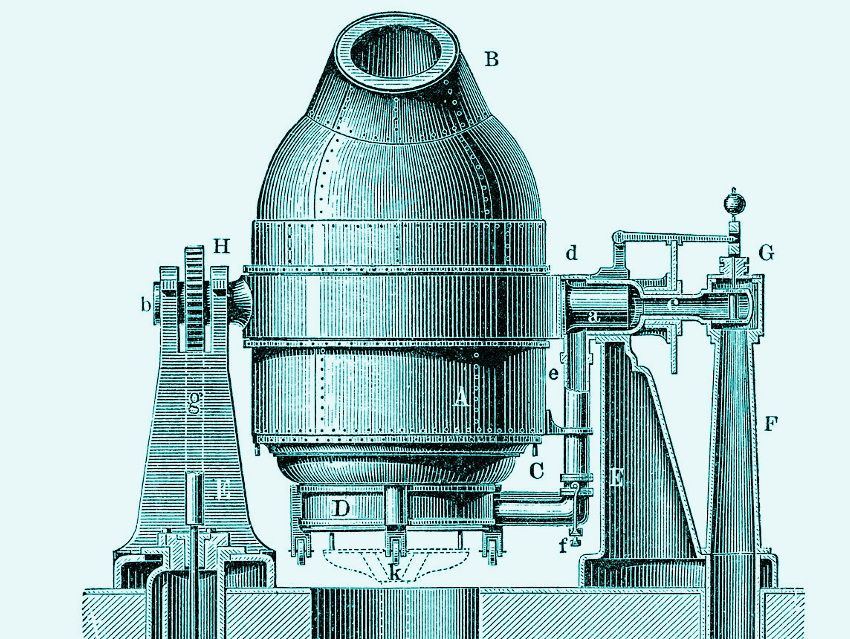“I have made a good discovery and can make more”—A True Fairy Tale For Entrepreneurs
When readers of the magazine Scientific American were asked about the most important technical discovery of their century in 1899, they didn’t choose Bell’s telephone or Edison’s lightbulb. Instead, they selected Bessemer’s process for the production of steel [1]. His 1855 patent “Regarding the Production of Malleable Iron by Blowing Air into a Pool of Molten Iron” eventually brought him lasting fame and immense wealth. Along the way, he made many other discoveries.
1. Henry Bessemer
Englishman Henry Bessemer (1813–1898, see Fig. 1) was a resourceful tinkerer, carrying out many experiments and learning from his failures. A discovery that seems unspectacular from today’s point of view made him financially independent from a young age, allowing him to pursue his boldest technical ideas without worries.
 |
|
Figure 1. Henry Bessemer. |
Henry Bessemer grew up in Charlton in Hertfordshire, north of London, UK. He was the son of an engineer who operated a type foundry. In his father’s workshop, he learned to handle both pure fluid metals and alloys, without formal professional training. He had a resourceful mind and developed amazing skill in molding and casting little sculptures by the age of seventeen.
In London, Italian traders offered plaster casts of antique reliefs and medallions for a penny each. Bessemer copied these and cast faithful metal reproductions. He treated the surfaces to make them look like they were made of real bronze [2]. These little works of art quickly became popular and sold well. At the age of 20, he took up the production of embossers, which led directly to his first major discovery.
2. A Terrific Idea with a Bitter Aftertaste
In 1694, William III of Great Britain introduced a stamp duty, for four years at first, to finance his war against France. Thereafter, lease and purchase contracts only became legally valid after acquiring a fee stamp for an appropriate amount from the British Stamp Office. The stamp could be embossed, glued on, or attached by a wire loop. This tax proved to be so lucrative that it persisted well beyond the intended four years, continuing to the present day.
Many people avoided the fees by removing the stamps from old expired contracts and using them to legalize new contracts. The British Stamp Office estimated an annual revenue loss of over 100,000 pounds in 1850.
At this time, Bessemer had an idea. He suggested to the Director of the British Stamp Office that the adhesive stamps be replaced with a more forgery-proof perforation to be stamped directly into the contract. He had himself developed and produced a suitable perforation machine, which punched 400 little holes into the paper or parchment. The director was enthusiastic and in view of the expected increase in revenue, offered Bessemer the position of “Superintendent of Stamps” instead of a cash payment. Bessemer accepted since the annual salary of 700 pounds would finally allow him to start a family.
When he broke the good news to his fiancée, Anne, she was very keen on the wedding plans and the prospect of a secure income, and patiently allowed Bessemer to describe his invention in detail. The young lady was impressed, but surprised her fiancé with a question [3]: “I understand this; but surely, if all the stamps had a date put on them, they could not at a future time be used again?”
Bessemer was stunned. “While I was pleased and proud at the clever and simple suggestion of the young lady, I also saw that all of my efforts were in vain. The work of many months, the toil of many a weary and lonely night, was for nothing. Indeed, stamping the date into the customary stamps was enough.”
Bessemer also presented his fiancée’s easier and less expensive proposal to the president of the British Stamp Office. He was confident that, “If I am successful in sparing the government large losses, they will reward me generously for it.”
In this, Bessemer was mistaken. The director of the British Stamp office immediately saw that Bessemer himself was not necessary for the implementation of the new stamps. He was declined a reward on the basis that he had volunteered the idea. Henry Bessemer was just 20 years old at the time, and this bitter experience influenced him for the rest of his life. He must have sworn to himself never to let this happen again and developed an almost pathological secretiveness in the implementation of his further inventions.
However, he never grew discouraged and always looked to the future with optimism: “I have made a good discovery and can make more. I will keep my eyes open and continue to try my luck.”
References
[1] Paul S. Collins, Banvard’s Folly: Tales of Renowned Obscurity, Famous Anonymity, and Rotten Luck, Picador, London, 2001. ISBN: 9780312268862
[2] J. Capus, What the steel industry owes to bronze powders, Met. Powder Rep. 2013, 68 (6), 31. https://doi.org/10.1016/S0026-0657(13)70215-7
[3] The quotations are taken from Bessemer’s autobiography. To increase readability, some parts were abbreviated or omitted. https://archive.org/details/sirhenrybessemer00bessuoft (accessed May 26, 2019)
The article has been published in German as:
- Sir Henrys geheimer Goldschatz,
Klaus Roth,
Chem. unserer Zeit 2018, 52, 416–425.
https://doi.org/10.1002/ciuz.201800876
and was translated by Caroll Pohl-Ferry.
Sir Henry’s Secret Pot of Gold – Part 1
A true fairy tale for entrepreneurs—with a rocky start
Sir Henry’s Secret Pot of Gold – Part 2
Henry Bessemer’s breakthrough method to make gold bronze
Sir Henry’s Secret Pot of Gold – Part 3
How Henry Bessemer would advise modern entrepreneurs and how he smartly outwitted his competitors
See similar articles by Klaus Roth published in ChemistryViews




